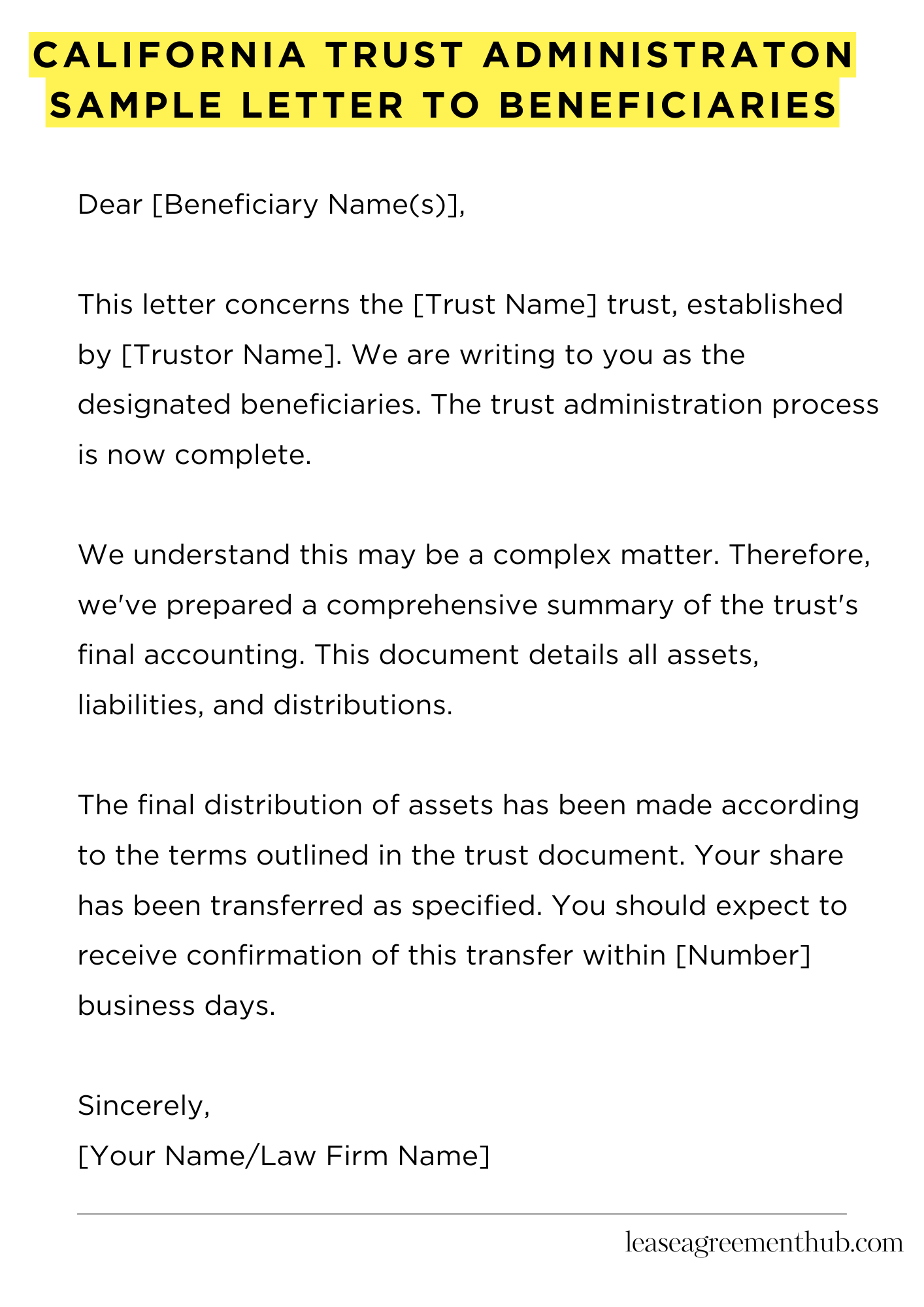A California trust administration letter to beneficiaries informs recipients about the trust’s status. It explains next steps. It keeps beneficiaries updated.
This article gives you examples. These are sample letters. You can use them as templates. They make writing your own letter easier.
We provide various examples. They cover different situations. You’ll find the right letter for your needs.
California Trust Administration Sample Letter to Beneficiaries
[Your Law Firm Letterhead]
[Date]
[Beneficiary Name(s)]
[Beneficiary Address]
Dear [Beneficiary Name(s)],
This letter concerns the [Trust Name] trust, established by [Trustor Name]. We are writing to you as the designated beneficiaries. The trust administration process is now complete.
We understand this may be a complex matter. Therefore, we’ve prepared a comprehensive summary of the trust’s final accounting. This document details all assets, liabilities, and distributions. You will find it attached to this letter. Please review it carefully.
The final distribution of assets has been made according to the terms outlined in the trust document. Your share has been transferred as specified. You should expect to receive confirmation of this transfer within [Number] business days. Please contact us immediately if you have any questions or concerns.
We are committed to providing you with the highest level of service and transparency. Our goal is to ensure a smooth and efficient transition of assets. We encourage you to contact us if further clarification is needed. We are available to answer any questions you may have.
Sincerely,
[Your Name/Law Firm Name]

How to Write a California Trust Administration Sample Letter to Beneficiaries
Understanding Your Audience: A Crucial First Step
Before even considering the verbiage, pinpoint your audience. Are your beneficiaries legal novices or seasoned investors? This dictates the tone and level of detail required. Clarity is paramount, but overly simplistic language might be perceived as condescending. Conversely, dense legal jargon can lead to obfuscation and confusion. Strive for a balanced approach, tailored to each recipient’s presumed understanding.
The Salutation: Setting the Right Tone
The salutation is more than a simple greeting; it’s the initial handshake of your correspondence. While a formal “Dear [Beneficiary Name]” remains appropriate, consider the pre-existing relationship with each beneficiary. A slightly more informal approach might be permissible if the relationship warrants it, fostering a sense of personal connection. However, err on the side of formality; undue familiarity can be unprofessional.
Concisely Outlining the Trust’s Administration
Provide a succinct overview of the trust’s administration. Avoid esoteric financial terminology; instead, prioritize lucidity. Explicitly state the actions you’ve completed thus far, such as asset appraisal, debt liquidation, and distribution planning. Use bullet points for enhanced readability and to delineate key milestones achieved. Transparency builds trust.
Detailing the Distribution Process: Transparency is Key
Describe the distribution process with unambiguous precision. Specify the assets allocated to each beneficiary, outlining the rationale behind any apportionment decisions. Addressing potential questions proactively minimizes future inquiries. If there are any anticipated delays or complexities, explain these forthrightly – honesty is the bedrock of effective communication. Detailing the timelines involved imparts a sense of order and competence.
Addressing Potential Contingencies and Obstacles
Proactively address any potential complications or unforeseen challenges. This proactive approach showcases your forethought and professionalism. For instance, if disputes arise among beneficiaries, mention procedures for conflict resolution. Mentioning contingencies without resorting to alarmist rhetoric is a sign of skillful communication.
The Closing: Maintaining Professionalism
The closing reiterates your commitment to transparency and availability. Offer contact information for further inquiries, ensuring beneficiaries feel supported throughout the process. A professional sign-off – “Sincerely,” followed by your name and title – concludes the correspondence with a formal touch. Choose a closing that aligns with the overall tone you’ve established.
Review and Revision: A Crucial Final Step
Before dissemination, meticulously review the letter for clarity, accuracy, and grammatical correctness. A proofread letter reflects your conscientiousness and attentiveness to detail. Consider seeking a second opinion from a colleague or legal professional to ensure the letter is both legally sound and effectively communicates the necessary information. A well-crafted letter minimizes misunderstandings and facilitates a smooth trust administration process.
FAQs about California Trust Administration Sample Letter to Beneficiaries
Understanding the communication process surrounding California trusts is crucial for both trustees and beneficiaries. Below are five frequently asked questions regarding sample letters to beneficiaries.
What is the purpose of a sample letter to beneficiaries from a California trust administrator?
A sample letter serves as a template for formal communication, ensuring consistency and clarity when informing beneficiaries about trust matters such as distributions, account updates, or significant events related to the trust.
What information should a sample letter to beneficiaries include?
Essential information includes the trustee’s identification, the trust’s name and identifying number, the beneficiary’s name and contact information, the date of the letter, a clear and concise explanation of the purpose of the communication, and any relevant details or actions required of the beneficiary.
Where can I find sample letters for California trust administration?
Sample letters can be found online through legal websites specializing in trust administration, estate planning resources, or legal professional websites. However, it is crucial to remember that these are samples and should be reviewed and adapted by legal counsel to fit the specific circumstances of the trust.
Are there legal requirements for communicating with beneficiaries of a California trust?
While there isn’t a specific prescribed format, California law mandates transparency and accountability from the trustee. Therefore, the letter should accurately reflect the trust’s status and actions taken. Failure to properly communicate can lead to legal challenges.
What should I do if I receive a letter I don’t understand?
Seek legal counsel immediately. A qualified estate attorney can review the letter and advise you on your rights and responsibilities as a beneficiary. Do not hesitate to seek clarification on any unclear or concerning information.
Related: